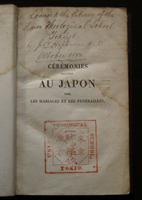The Japanese monographs studied by Hepburn
The Meiji Gakuin University Library holds monographs on Japan left by Hepburn, one of which is
Histoire et description generale du Japon, ou, L'on trouvera tout ce qu'on a pu apprendre de la nature & des
productions du pays, du caractère & des coûtumes des habitans, du gouvernement & du commerce, des révolutions
arrivées dans l'empire & dans la religion & l'examen de tous les auteurs, qui ont écrit sur le même sujet: avec
les fastes chronologiques de la découverte du nouveau monde: enrichie de figures en taille-douce(1736), authored
by the French missionary Charlevoix.
Unfortunately, parts of this 1736 edition are missing; the library holds Volumes Two, Seven, and Eight of this
nine-volume collection. There is an inscription on the cover indicating that Hepburn donated the works to the
Tokyo Union Theological School, one of the predecessor of Meiji Gakuin, in 1880 (Meiji 13).
 Histoire et description generale du Japon
Histoire et description generale du Japon
A second work is Cérémonies usitées au Japon, pour les mariages, les funérailles, et les principales fêtes de l'année : suivies d'anecdotes sur la dynastie régnante des souverains de cet empire, published in Paris in 1819,
 Cérémonies usitées au Japon
Cérémonies usitées au Japon
"What was it that provided the impetus for Hepburn to leave behind the management of a successful hospital in New
York in favor of the lands of the Far East?
Hepburn volunteered to come to Japan to work as a missionary doctor, rather than being sent. While his initial
action may be explained as aiming to propagate the word of Christ, the more one considers his actions, the more
questions one has: "Why did he choose Japan in the Far East? What did he imagine and expect the Japanese people
to be like? Among which classes of Japan did he wish to evangelize?" These questions can surely not be resolved
by a single answer.
Given Hepburn's compilation of the Waei Gorin Shūsei, it is obvious that he did not regard the Japanese people
as more primitive people. Rather than creating a dictionary of the official language of the samurai and court
nobles, he compiled one that included the language of common folk from every class, giving the impression that
he appreciated Japan as a country with an original culture and history, and the populace of Japan as a people
with a particular way of living. Moreover, Hepburn's attitude differed greatly to that reflected by the methods
employed by the Jesuit missionaries; he connected sincerely with all the Japanese people he came into contact
with. Why did he have this kind of attitude? Hepburn's attitude suggests that he held an image of the Japanese
people before even arriving in Japan.
These two books perhaps go some way toward providing answers to such questions. Perhaps it was in fact the image
of Japanese people in Nagasaki and Amakusa, living lives true to themselves amongst the pressure of Christianity
in the early Edo era, and the image of Japanese people with their particular, original culture, that first
attracted Hepburn to Japan.
